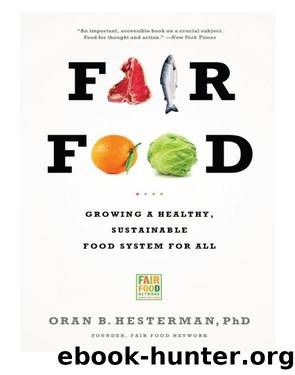Fair Food by Hesterman Oran B

Author:Hesterman, Oran B.
Language: eng
Format: epub
Publisher: PublicAffairs
Published: 2012-04-24T16:00:00+00:00
Buy Local
The trend toward local food has caught on with a vengeance. Farmersâ markets have increased more than threefold since 1994, and just in the past five years, direct farm-to-consumer sales have more than doubled.13 Many in the food retail industry would say that this is the most significant current trend in food. Grocery stores large and small proudly display signs that tell us âlocally grown by farmers in this area.â Sometimes pictures of the farmers even hang over the produce section. And many restaurants now feature meals made from ingredients grown by farmers in the area. Local food has not always been this trendy. Capturing this trend as an opportunity to redesign the food system is challenging, but there are communities across the country doing just that. And it started with a single initiative almost twenty years ago.
In 1993, one of the first projects we funded in our Integrated Farming Systems program at the Kellogg Foundation was known as CISA (Community Involved in Sustaining Agriculture) in western Massachusetts. The projectâs major institutional collaborators were Hampshire College, the University of Massachusetts, and the Pioneer Valley Growers Association. Over time, many other organizations, businesses, and individuals became involved. The goal of this project was to organize and implement community-wide efforts that could sustain small-scale agriculture as a viable enterprise in an area where the pressure to sell farmland for development was intense. (Due to its topography, the area is not well suited for larger-scale agriculture, so consolidating farm operations as a strategy for financial survival was not an option.)
One of the ideas of the project team was to create focused communications that would feature local farmers and encourage shoppers in the Amherst-Northampton area to buy as much of their groceries as possible from them. The budget originally submitted to and approved by the Kellogg Foundation did not contain sufficient funding to conduct a sophisticated communications campaign. I suggested that Kellogg fund this effort, but only if the group was willing to work in a more professional manner than having staff dressed in apple and carrot costumes at the county fair. We funded focus groups to determine the most effective messaging and to explore the values that people in that community held that could be related to local food. We then connected CISA with top-notch communications professionals who knew how to poll and had a track record in creating mailings, radio, and print communications for successful political campaigns, and we asked them to create the campaign.
The âBe a Local Hero, Buy Locally Grownâ effort was a resounding success. More than 60 percent of the residents in the target communities were aware of the campaign and had heard about it in the media, and the local farmers who were involved were reporting sales increases of more than 10 percent. Even more telling was what happened with such food retailers as Stop & Shop, the largest grocer in the area. Before the campaign began, CISA staff met with produce buyers from Stop & Shop and other local grocers to ask if they would like to be part of the program.
Download
This site does not store any files on its server. We only index and link to content provided by other sites. Please contact the content providers to delete copyright contents if any and email us, we'll remove relevant links or contents immediately.
Life 3.0: Being Human in the Age of Artificial Intelligence by Tegmark Max(5474)
The Sports Rules Book by Human Kinetics(4290)
The Age of Surveillance Capitalism by Shoshana Zuboff(4209)
ACT Math For Dummies by Zegarelli Mark(3991)
Unlabel: Selling You Without Selling Out by Marc Ecko(3587)
Blood, Sweat, and Pixels by Jason Schreier(3565)
Hidden Persuasion: 33 psychological influence techniques in advertising by Marc Andrews & Matthijs van Leeuwen & Rick van Baaren(3472)
The Pixar Touch by David A. Price(3362)
Bad Pharma by Ben Goldacre(3354)
Urban Outlaw by Magnus Walker(3338)
Project Animal Farm: An Accidental Journey into the Secret World of Farming and the Truth About Our Food by Sonia Faruqi(3177)
Kitchen confidential by Anthony Bourdain(3007)
Brotopia by Emily Chang(3000)
Slugfest by Reed Tucker(2937)
The Content Trap by Bharat Anand(2860)
The Airbnb Story by Leigh Gallagher(2797)
Coffee for One by KJ Fallon(2565)
Smuggler's Cove: Exotic Cocktails, Rum, and the Cult of Tiki by Martin Cate & Rebecca Cate(2469)
Beer is proof God loves us by Charles W. Bamforth(2370)
